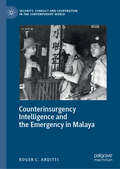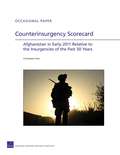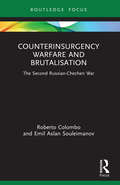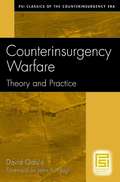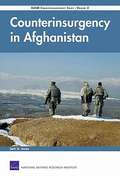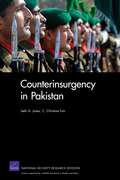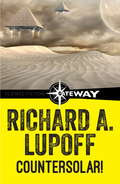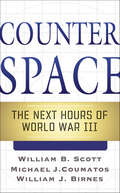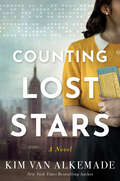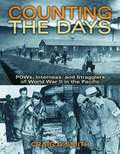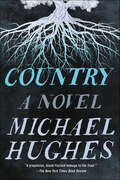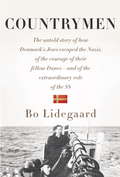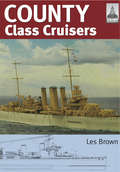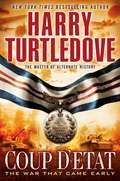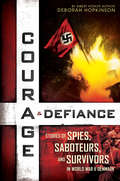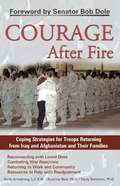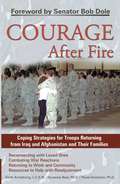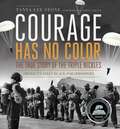- Table View
- List View
Counterinsurgency Intelligence and the Emergency in Malaya (Security, Conflict and Cooperation in the Contemporary World)
by Roger C. ArdittiThis book examines the full range of counterinsurgency intelligence during the Malayan Emergency. It explores the involvement of the Security Service, the Joint Intelligence Committee (Far East), the Malayan Security Service, Special Branch and wider police service, and military intelligence, to examine how British and Malayan authorities tackled the insurgent challenge posed by the Malayan Communist Party. This study assesses the nature of the intelligence apparatus prior to the declaration of emergency in 1948 and considers how officials attempted to reconstruct the intelligence structures in the Far East after the surrender of the Japanese in 1945. These plans were largely based upon the legacy of the Second World War but quickly ran into difficultly because of ill-defined remits and personality clashes. Nevertheless, officials did provide prescient warning of the existential threat posed by the Malayan Communist Party from the earliest days of British reoccupation of Malaya. Once a state of emergency had been declared, officials struggled to find the right combination of methods, strategy and management structures to eliminate the threat posed by the Communist insurgents. This book argues that the development of an effective counterinsurgency intelligence strategy involved many more organisations than just Special Branch. It was a multifaceted, dynamic effort that took far longer and was more problematic than previous accounts suggest. The Emergency remains central to counterinsurgency theory and thus this wide-ranging analysis sheds crucial light not only on the period, but on contemporary doctrine and security practices today.
Counterinsurgency Scorecard: Afghanistan In Early 2011 Relative to the Insurgencies of the Past 30 Years
by Christopher PaulA core finding of previous RAND research on 30 years of insurgencies worldwide was that a conflict's overall score on a scorecard of 15 equally weighted good and 12 equally weighted bad counterinsurgency factors and practices perfectly predicted the ultimate outcome. Using the scorecard approach and an expert elicitation (Delphi) exercise, a RAND project sought to extend the findings to the case of Afghanistan in early 2011.
Counterinsurgency Warfare and Brutalisation: The Second Russian-Chechen War (Cass Military Studies)
by Roberto Colombo Emil Aslan SouleimanovThis book offers the first analysis of the brutalisation paradigm in counter-insurgency warfare. Minimising the use of force and winning over the population’s opinion is said to be the cornerstone of success in modern counterinsurgency (COIN). Yet, this tells only one side of the story. Drawing upon primary data collected during interviews with eyewitnesses of the Second Russian-Chechen War, as well as from secondary sources, this book is the first to offer a detailed analysis of the long-neglected logic underpinning brutalisation-centred COIN campaigns. It offers a comprehensive systematisation of the brutalisation paradigm and challenges the widespread assumption of brutalisation as an underperforming paradigm of COIN warfare. It shows that, although appalling, brutalisation-centred measures can deliver success. The book also outlines a stigmatised yet widely deployed set of COIN measures and provides critical insights into how Western military blueprints can be improved without compromising important moral and ethical requirements. This book will be of much interest to students of counterinsurgency, military and strategic studies, Russian politics, and International Relations.
Counterinsurgency Warfare: Theory and Practice
by David GalulaThis book provides an analysis of how to countermand insurgency and the elements that might hinder its defeat. Inspired by his military experiences as a French military officer and attache in China, Greece, Southeast Asia, and Algeria, the author realized the "need for a compass" in the suppression of insurgency, and he set out to "define the laws of counterinsurgency warfare, to deduce from them its principles, and to outline the corresponding strategy and tactics." Written in 1964, the book in its new printing is as relevant now as it was forty years ago. Counterinsurgency Warfare provides the template for the defeat of today's insurgents and terrorists.
Counterinsurgency in Afghanistan: Rand Counterinsurgency Study
by Seth G. JonesThis study explores the nature of the insurgency in Afghanistan, the key challenges and successes of the U.S.-led counterinsurgency campaign, and the capabilities necessary to wage effective counterinsurgency operations. By examining the key lessons from all insurgencies since World War II, it finds that most policymakers repeatedly underestimate the importance of indigenous actors to counterinsurgency efforts. The U.S. should focus its resources on helping improve the capacity of the indigenous government and indigenous security forces to wage counterinsurgency. It has not always done this well. The U.S. military-along with U.S. civilian agencies and other coalition partners-is more likely to be successful in counterinsurgency warfare the more capable and legitimate the indigenous security forces (especially the police), the better the governance capacity of the local state, and the less external support that insurgents receive.
Counterinsurgency in Crisis: Britain and the Challenges of Modern Warfare (Columbia Studies in Terrorism and Irregular Warfare)
by David H. Ucko Egnell Robert. Foreword by Colin Gray.Long considered the masters of counterinsurgency, the British military encountered significant problems in Iraq and Afghanistan when confronted with insurgent violence. In their effort to apply the principles and doctrines of past campaigns, they failed to prevent Basra and Helmand from descending into lawlessness, criminality, and violence. By juxtaposing the deterioration of these situations against Britain's celebrated legacy of counterinsurgency, this investigation identifies both the contributions and limitations of traditional tactics in such settings, exposing a disconcerting gap between ambitions and resources, intent and commitment. Building upon this detailed account of the Basra and Helmand campaigns, this volume conducts an unprecedented assessment of British military institutional adaptation in response to operations gone awry. In calling attention to the enduring effectiveness of insurgent methods and the threat posed by undergoverned spaces, David H. Ucko and Robert Egnell underscore the need for military organizations to meet the irregular challenges of future wars in new ways.
Counterinsurgency in Modern Warfare
by Daniel Marston Carter MalkasianThrough history armies of occupation and civil power have been repeatedly faced with the challenges of insurgency. US involvement in Iraq and Afghanistan has highlighted this form of conflict in the modern world. Armies, sometimes reluctantly, have had to adopt new doctrines and tactics to deal with the problems of insurgency and diverse counterinsurgency strategies have been developed. These have ranged from conventional military operations to a combination of military and political strategy including propaganda, Psy-Ops, and other approaches. In Counterinsurgency in Modern Warfare 13 contributors examine developments in counterinsurgency from the early 20th century to the present. Each author, an expert in his field, discusses in depth the conduct and outcomes of operations across the globe, including the Arab-Israeli conflict, Afghanistan and Iraq, and draws out the lessons to be learned from them. This book is a timely, serious yet accessible survey of a critical facet of modern warfare and present-day global conflict.
Counterinsurgency in Pakistan
by Seth G. Jones C. Christine FairPakistan has undertaken a number of operations against militant groups since 2001. There have been some successes, but such groups as al Qa'ida continue to present a significant threat to Pakistan, the United States, and other countries. Pakistan needs to establish a population-centric counterinsurgency that better protects the local population and addresses grievances. It also needs to abandon militancy as a tool of foreign and domestic policy.
Counterinsurgency, Security Forces, and the Identification Problem: Distinguishing Friend From Foe (Studies in Insurgency, Counterinsurgency and National Security)
by Daniel L. Magruder, JrThis book presents a theory and empirical evidence for how security forces can identify militant suspects during counterinsurgency operations. A major oversight on the part of academics and practitioners has been to ignore the critical antecedent issue common to persuasion and coercion counterinsurgency (COIN) approaches: distinguishing friend from foe. This book proposes that the behaviour of security forces influences the likelihood of militant identification during a COIN campaign, and argues that security forces must respect civilian safety in order to create a credible commitment to facilitate collaboration with a population. This distinction is important as conventional wisdom has wrongly assumed that the presence of security forces confers control over terrain or influence over a population. Collaboration between civilian and government actors is the key observable indicator of support in COIN. Paradoxically, this theory accounts for why and how increased risk to government forces in the short term actually improves civilian security in the long run. Counterinsurgency, Security Forces, and the Identification Problem draws on three case studies: the Huk Rebellion in the Philippines post-World War II; Marines Corps’ experiences in Vietnam through the Combined Action Program; and Special Operations activities in Iraq after 2003. For military practitioners, the work illustrates the critical precursor to establishing "security" during counterinsurgency operations. The book also examines the role and limits of modern technology in solving the identification problem. This book will be of interest to students of counterinsurgency, military history, strategic studies, US foreign policy, and security studies in general.
Counterinsurgency: Theory and Reality (Casemate Short History)
by Stuart Mitchell Dr. Daniel WhittinghamAn overview of modern Western militaries&’ response to armed rebellion, from Indochina to Northern Ireland to Iraq. Counterinsurgency—or efforts to defeat and confine a rebellion against a constituted authority—has become a buzzword in recent times, but the term is as old as society itself. This concise history covers the development of modern counterinsurgency over the last two hundred years, from the concept of &“small wars&” and colonial warfare to the ideas of early insurgents like Clausewitz and the theories of Lawrence of Arabia to the methods of twentieth-century insurgents including Mao and Che Guevara. It also examines a number of post-1945 insurgencies and how Western armies have tried to counter them, in particular the French in Indochina and Algeria, as well as the United States in Vietnam and the reaction to the American experience there. This is compared with the British approach in the years after World War II, particularly in Malaya, but also in Kenya and Northern Ireland. Against this backdrop, there is an investigation of counterinsurgency in Afghanistan and Iraq, the rise of COIN literature, and the subsequent backlash against that literature—and finally, a discussion of the future of COIN.
Countersolar!: Twin Planets Book 2
by Richard A. LupoffOn the other side of the sun, opposite our earth, is a world we never see Counterearth. In every way it's identical to ours...almost!Albert Einstein, Juan (and Eva) Peron, Babe Didrickson and Sir Oswald Mosley are off on a wild race to Counterearth. It's all action and excitement against a historical background - in fact against two historical backgrounds - detailed enough to intrigue any history buff. It's January 1942; Cordell Hull is President of the United States; and the good guys take off in their spaceship, Manta, from the deck of the SS Titanic, steaming back from Liverpool to New York with thousands of New Year's revellers on board.
Counterspace: The Next Hours of World War III
by William J. Birnes William B. Scott Michael J. Coumatos“Takes us to the front lines of the space- and cyber-security world. A must-read to preview how our national-security future will unfold!” —Gen. Richard B. Myers (USAF-Ret.), former Chairman, Joint Chiefs of StaffIn Space Wars, Scott, Coumatos, and Birnes created a fascinating war gaming scenario of how World War III might unfold above the Earth’s surface. Now this thrilling team of writers reunites with Counterspace, an even more chilling fictionalized look at America’s most catastrophic fears.What if North Korea detonated a nuclear weapon in space and silenced dozens of satellites?What if an Iranian missile threatened to destroy Israel, while a Venezuelan “research” satellite endangered one of the US’s most promising space initiatives?What if tech-savvy terrorist cells unleashed back-to-back horrors in California, creating an avalanche of crises overnight, as national leaders robbed of spy satellite imagery were forced to make decisions in the “blind?”These are the scenarios of Counterspace, a frighteningly plausible look at threats to the United States and the world. Scott, Coumatos, and Birnes use war gaming scenarios to show how the US Strategic Command might choose to fight off these menaces and prevent global disaster. Combining current and future technology with our enemies’ grandest plans, Counterspace is equally a terrifying possibility and a hopeful affirmation that America can and will be ready to face such dangers, told with the pulse-pounding power of a modern-day thriller.“A page-turning techno-thriller . . . the story reads like today’s headlines, faithfully taking the reader inside the minds of madmen, heroes and space warriors.” —Elliot Holokauahi Pulham, Chief Executive Officer, The Space Foundation
Counting Lost Stars: A Novel
by Kim van AlkemadeNew York Times bestselling author of Orphan #8, Kim van Alkemade returns with a gripping and poignant historical saga in which an unmarried college student who’s given up her baby for adoption helps a Dutch Holocaust survivor search for his lost mother.1960, New York City: College student Rita Klein is a pioneering woman in the new field of computer programming—until she unexpectedly becomes pregnant. At the Hudson Home for Unwed Mothers, social workers pressure her into surrendering her baby for adoption. Rita is struggling to get on with her life when she meets Jacob Nassy, a charming yet troubled man from the Netherlands who is traumatized by his childhood experience of being separated from his mother during the Holocaust. When Rita learns that Hitler’s Final Solution was organized using Hollerith punch-card computers, she sets out to find the answers that will help Jacob heal.1941, The Hague: Cornelia Vogel is working as a punch-card operator at the Ministry of Information when a census of Holland’s population is ordered by the Germans. After the Ministry acquires a Hollerith computer made in America, Cornelia is tasked with translating its instructions from English into Dutch. She seeks help from her fascinating Jewish neighbor, Leah Blom, an unconventional young woman whose mother was born in New York. When Cornelia learns the census is being used to persecute Holland’s Jews, she risks everything to help Leah escape.After Rita uncovers a connection between Cornelia Vogel and Jacob’s mother, long-buried secrets come to light. Will shocking revelations tear them apart, or will learning the truth about the past enable Rita and Jacob to face the future together?
Counting the Days: POWs, Internees, and Stragglers of World War II in the Pacific
by Craig B. SmithCounting the Days is the story of six prisoners of war imprisoned by both sides during the conflict the Japanese called the "Pacific War." As in all wars, the prisoners were civilians as well as military personnel. Two of the prisoners were captured on the second day of the war and spent the entire war in prison camps: Garth Dunn, a young Marine captured on Guam who faced a death rate in a Japanese prison 10 times that in battle; and Ensign Kazuo Sakamaki, who suffered the ignominy of being Japanese POW number 1. Simon and Lydia Peters were European expatriates living in the Philippines; the Japanese confiscated their house and belongings, imprisoned them, and eventually released them to a harrowing jungle existence caught between Philippine guerilla raids and Japanese counterattacks. Mitsuye Takahashi was a U.S. citizen of Japanese descent living in Malibu, California, who was imprisoned by the United States for the duration of the war, disrupting her life and separating her from all she owned. Masashi Itoh was a Japanese soldier who remained hidden in the jungles of Guam, held captive by his own conscience and beliefs until 1960, 15 years after the end of the war. This is the story of their struggles to stay alive, the small daily triumphs that kept them going—and for some, their almost miraculous survival.
Country: A Novel
by Michael HughesPublished to ravishing acclaim in the UK, a fierce and suspenseful reimagining of Homer’s Iliad set in mid-1990s Northern Ireland—a heart pounding tale of honor and revenge that “explodes with verbal invention, rapid juxtaposition, brutality and fun” (Times Literary Supplement).Northern Ireland, 1996.After twenty-five years of vicious conflict, the IRA and the British have agreed to an uneasy ceasefire as a first step towards lasting peace. But, faced with the prospect that decades of savage violence and loss have led only to smiles and handshakes, those on the ground in the border country question whether it really is time to pull back—or quite the opposite.When an IRA man’s wife turns informer, he and his brother gather their comrades for an assault on the local army base. But old grudges boil over, and the squad's feared sniper, Achill, refuses to risk his life to defend another man’s pride. As the gang plots without him, the British SAS are sent to crush the rogue terror cell before it can wreck the fragile truce and drag the region back to the darkest days of the Troubles. Meanwhile, Achill’s young protégé grabs his chance to join the fray in his place…Inspired by the oldest war story of them all, Michael Hughes’s virtuoso novel explores the brutal glory of armed conflict, the cost of Ireland’s most uncivil war, and the bitter tragedy of those on both sides who offer their lives to defend the dream of country.
Countrymen
by Bo LidegaardAmid the dark, ghastly history of World War II, the literally extraordinary story, never before fully researched by a historian, of how the Danish people banded together to save their fellow Jews from the Nazis--told through the remarkable unpublished diaries and documents of families forced to run for safety, leaving their homes and possessions behind, and of those who courageously came to their aid. In 1943, with its king and administration weakened but intact during the Nazi occupation, Denmark did something that no other country in Western Europe even attempted. Anticipating that the German occupying powers would soon issue the long-feared order to round up the entire population of Jews for deportation to concentration camps, the Danish people stood up in defiance and resisted. The king, politicians, and ordinary civilians were united in their response--these threatened people were not simply Jews but fellow Danes who happened to be Jewish, and no one would help in rounding them up for confinement and deportation. While diplomats used their limited but very real power to maneuver and impede matters in both Copenhagen and Berlin, the warning that the crisis was at hand quickly spread through the Jewish community. Over fourteen harrowing days, as they were helped, hidden, and protected by ordinary people who spontaneously rushed to save their fellow citizens, an incredible 7,742 out of 8,200 Jewish refugees were smuggled out all along the coast--on ships, schooners, fishing boats, anything that floated--to Sweden. While the bare facts of this exodus have been known for decades, astonishingly no full history of it has been written. Unfolding on a day-to-day basis, Countrymen brings together accounts written by individuals and officials as events happened, offering a comprehensive overview that underlines occupied Denmark's historical importance to Hitler as a prop for the model Nazi state and revealing the savage conflict among top Nazi brass for control of the country. This is a story of ordinary glory, of simple courage and moral fortitude that shines out in the midst of the terrible history of the twentieth century and demonstrates how it was possible for a small and fragile democracy to stand against the Third Reich.
County Class Cruisers
by Les Brown&“A detailed look at British 10,000-ton Treaty Cruisers. &“A gem of research by the author, covering the design and progressive improvements to each ship.&”—Malcolm Wright, author of British and Commonwealth Warship Camouflage of WWII The ShipCraft series provides in-depth information about building and modifying model kits of famous warship types. Lavishly illustrated, each book takes the modeler through a brief history of the subject class, highlighting differences between sisterships and changes in their appearance over their careers. This includes paint schemes and camouflage, featuring color profiles and highly detailed line drawings and scale plans. The modeling section reviews the strengths and weaknesses of available kits, lists commercial accessory sets for super-detailing of the ships, and provides hints on modifying and improving the basic kit. This is followed by an extensive photographic gallery of selected high-quality models in a variety of scales, and the book concludes with a section on research references books, monographs, large-scale plans and relevant websites. This volume covers the British 10,000-ton Treaty Cruisers, thirteen of which were built to three slightly varying designs between the wars. With three funnels and a high freeboard, they were impressive ships, and all enjoyed very active wartime careers—three were involved in the Bismarck action and another with the sinking of the Scharnhorst. &“This book by Les Brown is rather like the Sci-Fi &‘Tardis&’ in that its outside belies the tremendous amount on the inside.&”—Malcolm Wright, author of British and Commonwealth Warship Camouflage of WWII
Coup d'Etat: The War That Came Early, Book Four (The War That Came Early #4)
by Harry TurtledoveIn 1941, a treaty between England and Germany unravels--and so does a different World War II. In Harry Turtledove's mesmerizing alternate history of World War II, the choices of men and fate have changed history. Now it is the winter of 1941. As the Germans, with England and France on their side, slam deep into Russia, Stalin's terrible machine fights for its life. But the agreements of world leaders do not touch the hearts of soldiers. The war between Germany and Russia is rocked by men with the courage to aim their guns in a new direction. England is the first to be shaken. Following the suspicious death of Winston Churchill, with his staunch anti-Nazi views, a small cabal begins to imagine the unthinkable in a nation long famous for respecting the rule of law. With civil liberties hanging by a thread, a conspiracy forms against the powers that be. What will this daring plan mean for the European war as a whole? Meanwhile, in America, a woman who has met Hitler face-to-face urges her countrymen to wake up to his evil. For the time being, the United States is fighting only Japan--and the war is not going as well as Washington would like. Can Roosevelt keep his grip on the country's imagination? Coup d'Etat captures how war makes for the strangest of bedfellows. A freethinking Frenchman fights side by side with racist Nazis. A Czech finds himself on the dusty front lines of the Spanish Civil War, gunning for Germany's Nationalist allies. A German bomber pilot courts a half-Polish, half-Jewish beauty in Bialystock. And the Jews in Germany, though trapped under Hitler's fist, are as yet protected by his fear of looking bad before the world--and by an outspoken Catholic bishop. With his spectacular command of character, coincidence, and military and political strategies, Harry Turtledove continues a passionate, unmatched saga of a World War II composed of different enemies, different allies--and hurtling toward a horrific moment. For a diabolical new weapon is about to be unleashed, not by the United States, but by Japan, in a tactic that will shock the world.From the Hardcover edition.
Coup d'État: A Practical Handbook, Revised Edition
by Edward N. LuttwakEdward Luttwak's shocking 1968 handbook showed, step-by-step, how governments could be overthrown and inspired anti-coup precautions around the world. In addition to these instructions, his revised handbook offers a new way of looking at political power--one that considers the vulnerability of stable democracies after prolonged economic distress.
Courage & Defiance: Stories of Spies, Saboteurs, and Survivors in World War II Denmark (Scholastic Press Novels)
by Deborah HopkinsonCritically acclaimed Sibert Honor author Deborah Hopkinson brings to bold life the remarkable story of the Danish resistance and rescue of over 7,000 Jews during WWII.When the Nazis invaded Denmark the morning of Tuesday, April 9, 1940, the people of this tiny country to the north of Germany awoke to a devastating surprise. The government of Denmark surrendered quietly, and the Danes were ordered to go about their daily lives as if nothing had changed. But everything had changed. Award-winning author Deborah Hopkinson traces the stories of the heroic young men and women who would not stand by as their country was occupied. Rather, they fought back. Some were spies, passing tactical information to the British; some were saboteurs, who aimed to hamper and impede Nazi operations in Denmark; and 95% of the Jewish population of Denmark were survivors, rescued by their fellow countrymen, who had the courage and conscience that drove them to act. With her extraordinary talent for digging deep in her research and weaving real voices into her narratives, Hopkinson reveals the thrilling truth behind one of WWII's most daring resistance movements.
Courage After Fire: Coping Strategies for Troops Returning from Iraq and Afghanistan and Their Families
by Suzanne Best Paula Domenici Keith Armstrong<p>The bravery displayed by our soldiers at war is commonly recognized. However, often forgotten is the courage required by veterans when they return home and suddenly face reintegration into their families, workplaces, and communities. Authored by three mental health professionals with many years of experience counseling veterans, <i>Courage After Fire</i> provides strategies and techniques for this challenging journey home. <i>Courage After Fire<i> offers soldiers and their families a comprehensive guide to dealing with the all-too-common repercussions of combat duty, including posttraumatic stress symptoms, anxiety, depression, and substance abuse. It details state-of-the-art treatments for these difficulties and outlines specific ways to improve couple and family relationships. It also offers tips on areas such as rejoining the workforce and reconnecting with children.</p>
Courage After Fire: Coping Strategies for Troops Returning from Iraq and Afghanistan and Their Families
by Suzanne Best Paula Domenici Keith ArmstrongThe bravery displayed by our soldiers at war is commonly recognized. However, often forgotten is the courage required by veterans when they return home and suddenly face reintegration into their families, workplaces, and communities. Authored by three mental health professionals with many years of experience counseling veterans, Courage After Fire provides strategies and techniques for this challenging journey home.Courage After Fire offers soldiers and their families a comprehensive guide to dealing with the all-too-common repercussions of combat duty, including posttraumatic stress symptoms, anxiety, depression, and substance abuse. It details state-of-the-art treatments for these difficulties and outlines specific ways to improve couple and family relationships. It also offers tips on areas such as rejoining the workforce and reconnecting with children. &“A crucial tool for the men and women who have been serving our country so VALIANTLY during these past years.&” —Senator Bob Dole, from the foreword &“This extraordinary work will help the men and women returning from Iraq and Afghanistan find the COURAGE to rebuild their lives and be successful.&” —Honorable Anthony J. Principi, Former Secretary of Veterans Affairs
Courage Be My Friend: The Vivian Bullwinkel Story
by Jenny DavisSister Vivian Bullwinkel was the only survivor of the Bangka Island massacre during World War II. Her evocative story is told through the eyes of fifteen-year-old Edith ‘ Edie' Kenneison. Sister Bullwinkel enlisted in the Australian Army Nurse Service at the outbreak of World War II and was posted to Singapore. In February 1942, she and hundreds of others attempted to escape the advancing Japanese army but was captured and held as a prisoner of war. Vivian spent the next three years in captivity, working tirelessly to help her fellow prisoners. One of those prisoners was young Edie. Their remarkable friendship would help them survive and became the basis of a lifelong bond.
Courage Has No Color: The True Story of the Triple Nickles - America's First Black Paratroopers
by Tanya Lee StoneA 2014 YALSA Excellence in Nonfiction Finalist. They became America's first black paratroopers. Why was their story never told? Sibert Medalist Tanya Lee Stone reveals the history of the Triple Nickles during World War II. World War II is raging, and thousands of American soldiers are fighting overseas against the injustices brought on by Hitler. Back on the home front, the injustice of discrimination against African Americans plays out as much on Main Street as in the military. Enlisted black men are segregated from white soldiers and regularly relegated to service duties. At Fort Benning, Georgia, First Sergeant Walter Morris's men serve as guards at The Parachute School, while the white soldiers prepare to be paratroopers. Morris knows that for his men to be treated like soldiers, they have to train and act like them, but would the military elite and politicians recognize the potential of these men as well as their passion for serving their country? Tanya Lee Stone examines the role of African Americans in the military through the history of the Triple Nickles, America's first black paratroopers, who fought in a little-known attack on the American West by the Japanese. The 555th Parachute Infantry Battalion, in the words of Morris, "proved that the color of a man had nothing to do with his ability. " From Courage Has No Color What did it take to be a paratrooper in World War II? Specialized training, extreme physical fitness, courage, and -- until the 555th Parachute Infantry Battalion (the Triple Nickles) was formed -- white skin. It is 1943. Americans are overseas fighting World War II to help keep the world safe from Adolf Hitler's tyranny, safe from injustice, safe from discrimination. Yet right here at home, people with white skin have rights that people with black skin do not. What is courage? What is strength? Perhaps it is being ready to fight for your nation even when your nation isn't ready to fight for you.
